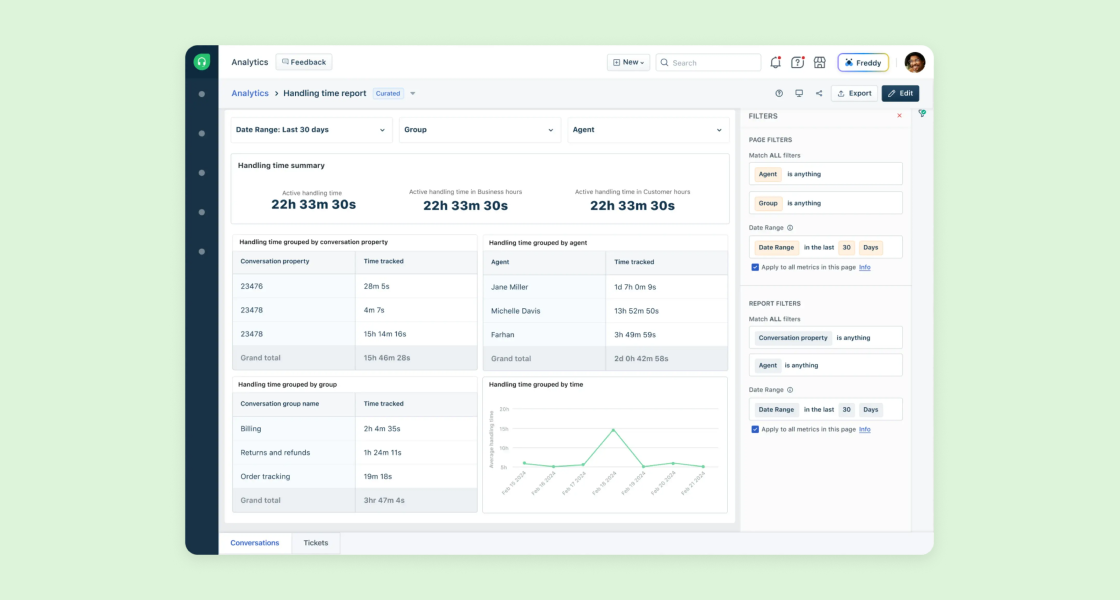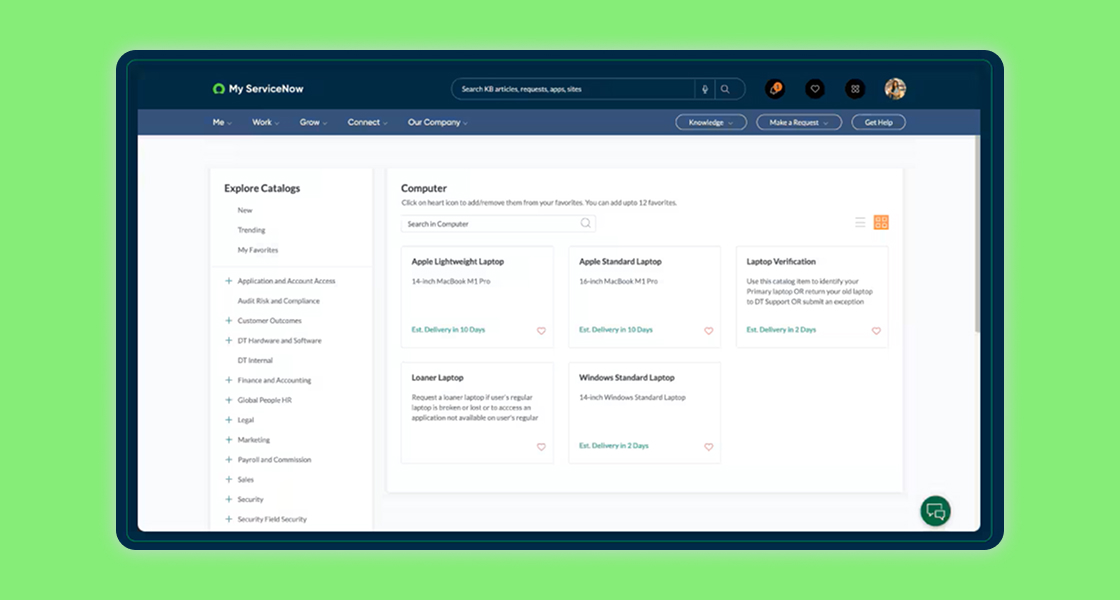Measure, Analyze, and Improve: How Freshdesk Analytics Boosts Customer Service Performance

The best customer support decisions aren’t driven by intuition, they’re driven by information. Every interaction, every ticket, and every response contains data that can reveal opportunities for improvement or early warning signs. Yet, that data only becomes valuable when it’s analyzed and transformed into concrete actions.
That’s where Freshdesk Analytics comes in, a solution designed to turn everyday information into a competitive advantage. With its powerful analytical capabilities, support teams can identify patterns, measure performance, and make data-driven decisions that directly impact customer satisfaction.
Today, providing fast and personalized support isn’t optional, it’s the standard. That’s why detailed metrics and insightful reports are no longer “nice to have”; they’re the engine of continuous improvement. In this article, you’ll discover how to unlock the full potential of Freshdesk Analytics to turn your data into intelligent decisions and elevate your customer support experience to the next level.
Why Analytics Matter for Support Teams
Most support teams are rich in data but lack actionable insights. Think of the countless tickets handled daily, dozens of workflows, and streams of customer feedback. Without analytics, this information is directionless, mere noise in the system. The right analytics platform, such as Freshdesk’s Advanced Analytics, transforms raw data into clear, actionable reports that illuminate:
- Operational bottlenecks and inefficiencies
- Agent performance disparities
- Customer pain points and satisfaction trends
- Process gaps and automation opportunities
By leveraging helpdesk reporting and dashboards, organizations gain the clarity needed for targeted coaching, process optimization, and ultimately a superior customer experience.
Understanding Freshdesk Analytics: Key Features
Before diving into action, it’s important to understand the toolkit at your disposal. Freshdesk Analytics offers a suite of features designed to cater to diverse reporting needs and business goals:
- Custom Reports: Powerful filters and customization options to create reports tailored to unique business objectives
- Pre-Built Reports & Dashboards: Quick access to essential KPIs, such as ticket volume, resolution times, and CSAT scores
- Custom Reports: Powerful filters and customization options to create reports tailored to unique business objectives
- Real-Time Dashboards: Live, interactive dashboards for immediate performance tracking
- Scheduled and Automated Reporting: Automate distribution of reports to keep leadership and agents informed without manual effort
- Custom Metrics & Widgets: Track specific metrics that matter most to your support team
With these tools, every aspect of your support operation, from high-level trends to granular team performance, becomes visible and actionable.
Making Metrics Matter: Choosing the Right Customer Support Metrics
The power of Freshdesk Analytics lies in what you measure and how you act upon it. Not all metrics are created equal; some shine a light on agent productivity, while others surface customer experience issues or process gaps. To drive meaningful improvements in support team performance, focus on a balanced mix of core metrics:
- First Response Time (FRT): Measures how quickly agents respond to customers after ticket creation
- Average Resolution Time (ART): Tracks how long it takes to fully resolve tickets
- First Contact Resolution (FCR): The percentage of issues resolved in the first agent engagement
- Ticket Backlog: Monitors unresolved or overdue tickets to prevent customer frustration
- CSAT (Customer Satisfaction) Scores: Direct insight into customer perception of your support quality
- Agent Utilization: Highlights workload distribution among agents
- Ticket Volume Trends: Identifies spikes or patterns signaling emerging issues
By understanding these vital customer support metrics, teams can benchmark performance, allocate resources more effectively, and set clear, achievable improvement targets.
Turning Data into Action: Actionable Insights with Freshdesk Analytics
With key metrics in hand, the next step is translating them into actionable strategies that genuinely move the needle. Here’s how Freshdesk Analytics empowers organizations to bridge the gap between insight and action:
1. Identifying Coaching Opportunities
Every support team has a mix of high-performing agents and those who need more guidance. Analytics reveal:
- Agents with longer response or resolution times
- Repeated escalations or negative feedback trends
- Gaps in knowledge resulting in frequent ticket reassignments
With this information, managers can design tailored coaching sessions, targeted training programs, and knowledge-sharing initiatives. Over time, an incremental increase in agent proficiency translates to measurable gains in team performance and customer satisfaction.
2. Process Refinement and Automation
Helpdesk reporting can uncover common bottlenecks within workflows, such as tickets stuck in pending states or multiple hand-offs between teams. These delays often indicate process inefficiencies that hinder first contact resolution and drive up response times.
By drilling down into specific ticket types, categories, or trajectory through workflows, support leads can:
- Redesign routing rules and SLAs
- Implement automation for repetitive or simple inquiries
- Standardize responses through knowledge base integration
- Reassign or balance workloads for optimal agent utilization
Every process improvement informed by analytics directly enhances both agent productivity and the customer experience.
3. Proactive Resource Planning
Freshdesk Analytics’ real-time dashboards help support teams anticipate upcoming workloads based on trends, such as seasonal peaks, product launches, or software updates. This foresight enables proactive resource planning and informed hiring decisions.
- Scale up agent coverage during anticipated spikes
- Realign teams to cover high-traffic channels
- Identify training needs and knowledge gaps in advance
- Spot patterns requiring long-term workflow adaptations
Leveraging these analytics-driven insights leads to fewer surprises and a more resilient support operation.
4. Closing the Feedback Loop with Customers
Customer feedback, captured through survey tools in Freshdesk (like CSAT or NPS), often ends up siloed or underutilized. However, using analytics to correlate feedback with operational data uncovers critical insights:
- Pinpoint patterns among dissatisfied customers (e.g., linked to specific products, agents, or time periods)
- Understand which processes or workflows contribute most to negative feedback
- Track the impact of implemented improvements on customer sentiment over time
This closed-loop approach demonstrates to customers that their voices are being heard and turned into meaningful change, a cornerstone of exceptional customer support.
5. Showcasing Wins and Driving Continuous Improvement
Support leaders must consistently communicate the value and progress of their teams. Freshdesk Analytics makes it easy to:
- Create custom reports showcasing improvements in key metrics
- Share visual dashboards with executives for strategic buy-in
- Celebrate individual and team achievements
- Highlight areas that still need focus, framing them as opportunities rather than failures
By making performance visible, and linking actions directly to outcomes, organizations foster a culture of accountability and continuous improvement.
Best Practices: Getting the Most Out of Freshdesk Analytics
Extracting maximum value from Freshdesk analytics requires more than simply running reports. Here are proven best practices for turning insights into action:
Regularly Review and Refine Key Metrics
- Revisit which metrics are tracked most closely every quarter
- Ensure chosen metrics align with current business objectives
- Retire vanity metrics and focus on those with clear actionability
Automate Report Distribution
- Set up automated report scheduling to ensure leadership and frontline teams receive timely updates
- Use tailored reports for different audiences, executive dashboards for leadership, granular reports for supervisors
Foster Data Literacy
- Train support managers and agents to interpret reports and dashboards accurately
- Empower teams to use data during daily standups or performance reviews
- Break down complex analytics concepts into simple, actionable language
Act and Iterate Based on Insights
- Don’t let reports languish; use them to drive weekly one-on-ones and team meetings
- Track the impact of process or coaching changes, then iterate based on ongoing metrics
- Solicit agent feedback on proposed changes uncovered via analytics
Integrate Analytics Across Business Functions
- Share findings with product, engineering, or sales teams to address root causes and close customer loops
- Work with marketing to spot trends in customer feedback affecting brand perception
- Turn support data into strategic input for continuous business-wide improvement
Measuring Support Team Performance: Sample Reporting Scenarios
Let’s ground these ideas in real-world reporting scenarios using Freshdesk analytics and helpdesk reporting tools. Here’s how to create actionable insights across three common support challenges:
Scenario 1: Improving First Response and Resolution Times
- Run a report on FRT and ART per agent, grouped by week. Identify outliers or consistent laggards.
- Analyze by ticket type or priority to spot specific sources of delay.
- Use trend dashboards to correlate spikes with team absences or product issues.
- Action: Provide targeted coaching for slow performers and adjust resource allocation during busy periods.
Scenario 2: Reducing Ticket Backlog and Escalation Rates
- Review backlog reports segmented by team, agent, and ticket category.
- Pinpoint ticket types most likely to be escalated or overdue.
- Invest in self-service articles for recurring or complex ticket topics.
- Action: Realign teams, automate low-complexity workflows, and set up early warning dashboards for supervisors.
Scenario 3: Boosting CSAT by Identifying Experience Gaps
- Correlate CSAT scores to ticket resolution times, channels (email, chat, phone), and agent assignments.
- Run feedback trend analysis over time and connect negative comments to process breakdowns.
- Share customer verbatims internally to build empathy and highlight improvement areas.
- Action: Create improvement sprints with metrics in focus, and monitor CSAT uplift post-implementation.
In each scenario, analytics drive discovery, action, and measurable results. Regularly reviewing, refining, and communicating these findings ensures continued progress and organizational buy-in.
Advanced Strategies: Custom Metrics and Data Visualization
Looking to level up your analytic capabilities? Freshdesk’s custom metric and dashboard builder allows for sophisticated, organization-specific reporting. Consider these advanced tactics:
- Composite KPIs: Build metrics that weight multiple factors (e.g., combining FRT, CSAT, and re-opened tickets for a holistic agent score)
- Customer Journey Tracking: Create lifecycle dashboards to monitor customer health across every support touchpoint
- Churn Correlation: Analyze support ticket history against churn data to spot patterns and build early intervention strategies
- Cross-Team Reporting: Blend support data with CRM or product analytics for 360-degree business insights
- Predictive Analytics: Experiment with trend forecasting to anticipate issues or surges before they impact customers
The custom widget and report builder in Freshdesk provides the flexibility to go far beyond out-of-the-box reports, empowering teams to innovate and continuously improve based on their unique needs.
The Path from Insights to Transformation
Customer service is both an art and a science, it requires empathy, experience, and data-driven precision. By harnessing the full potential of Freshdesk Analytics, your organization can uncover truly valuable insights, drive targeted improvements in team performance, and consistently deliver exceptional customer experiences.
To achieve this:
- Choose the right metrics aligned with your business goals.
- Use reports and dashboards to highlight performance and identify gaps.
- Empower your team through hands-on training, process optimization, and real-time resource planning.
- Close the loop with your customers to ensure lasting satisfaction and loyalty.
- Continuously evolve by adopting custom reports and advanced analytics techniques.
The journey from data to action isn’t always simple, but with the right tools, every report can become a catalyst for lasting transformation.
Are you ready to embrace truly data-driven support? Contact us today and discover how your team, and your customers, can thrive together.















